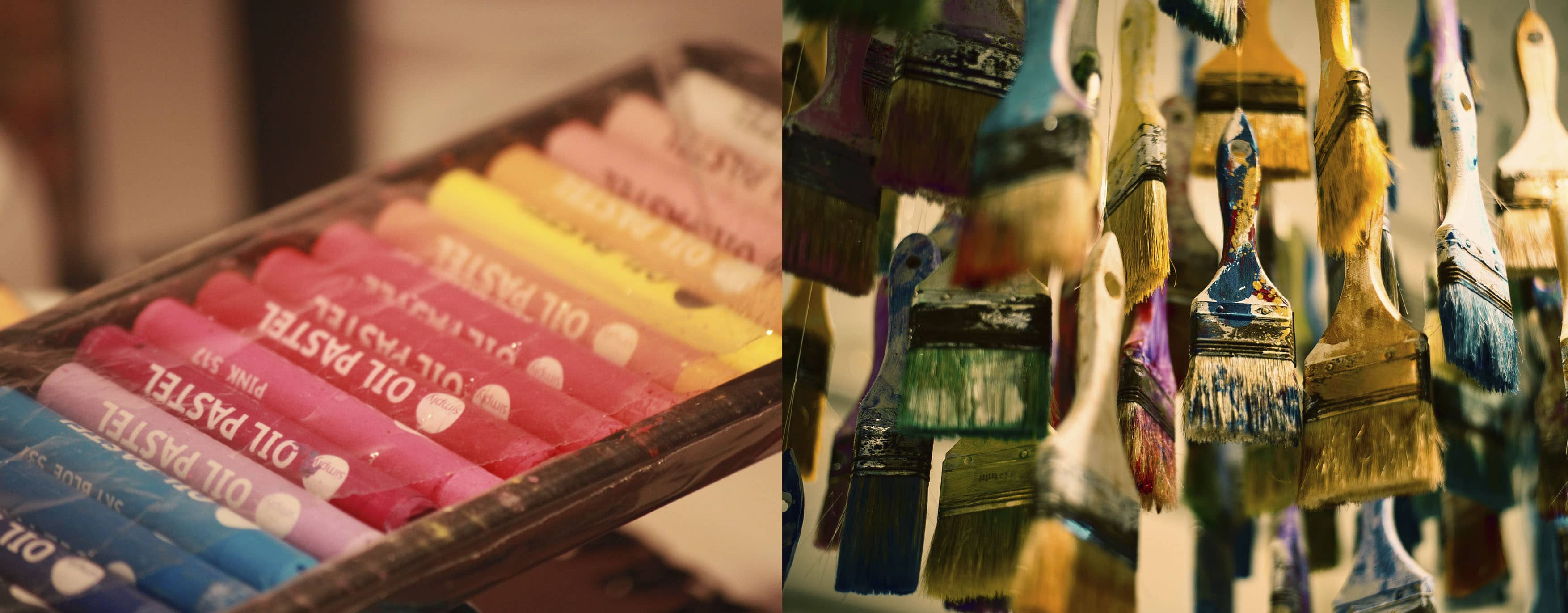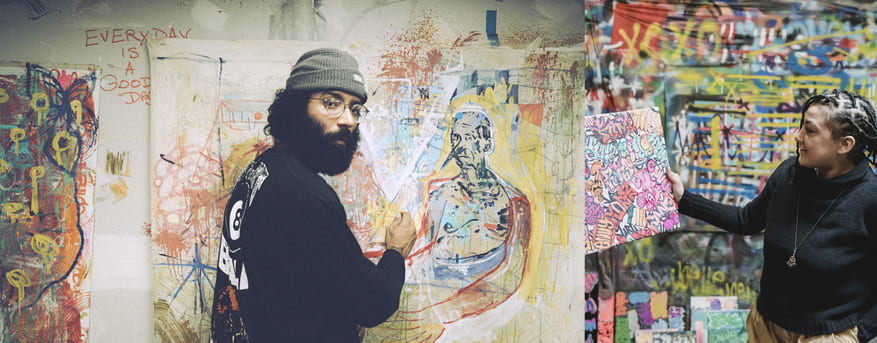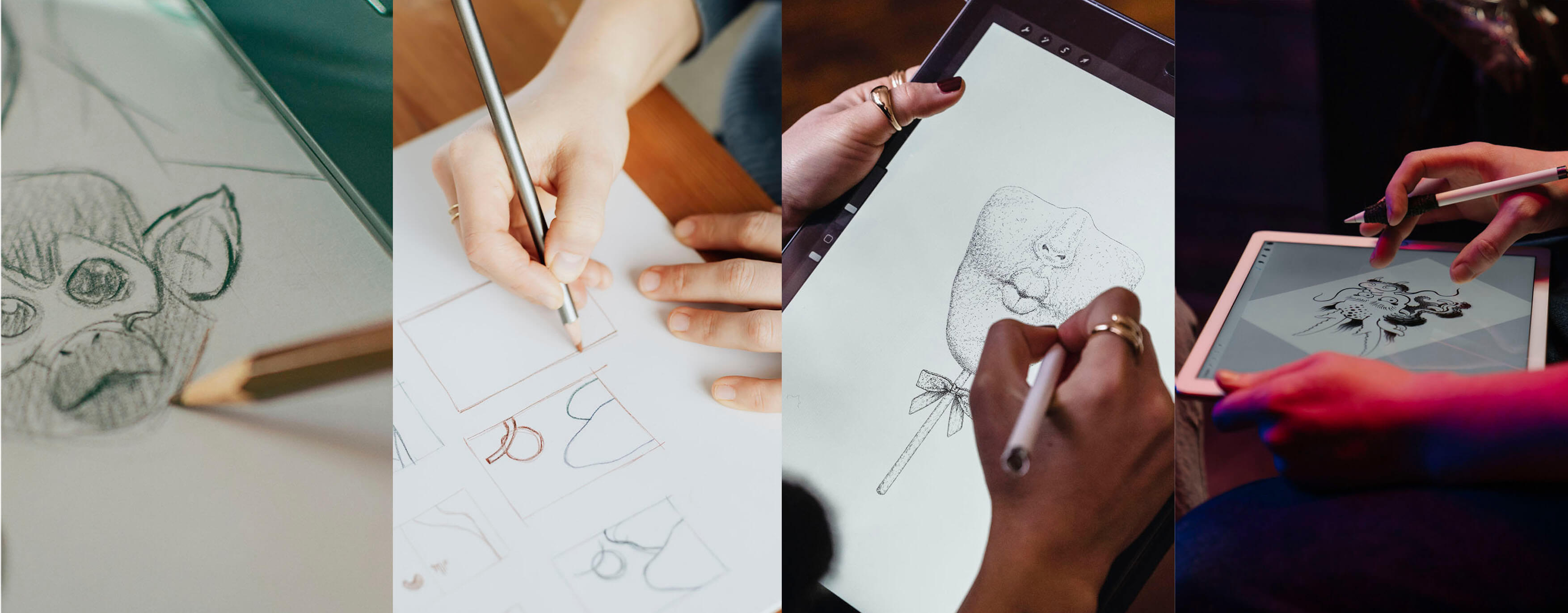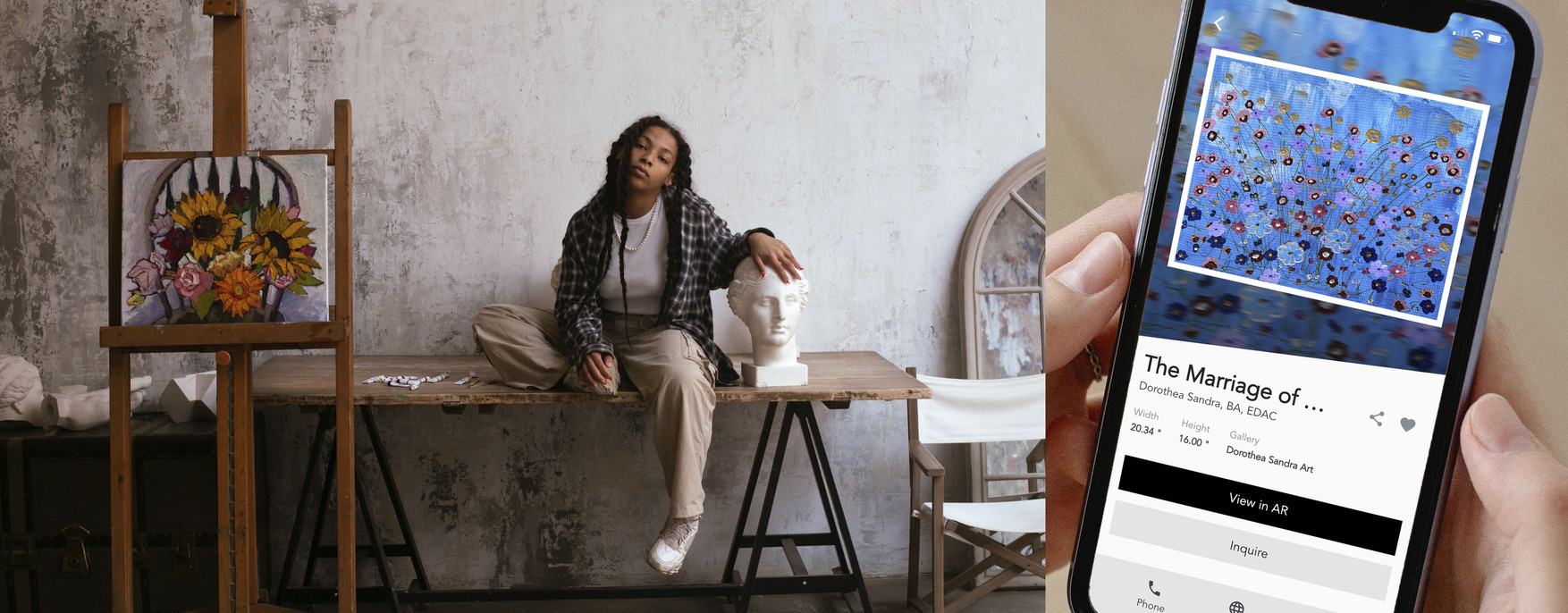Behind every great piece of art, there is a good set of art tools that enables the artist to achieve the end result they envisioned. Of course, practice is essential, but so is having the right art supplies to work with a particular technique.
Think about it, if you try to paint with watercolors over drawing paper, this won’t be able to absorb as much water, as a result, the paper (and the image) might warp and this might even affect how the pigment works. This might result in frustration if you are beginning to experiment with this technique, and this could all have been avoided by working with the right tools for artists.
To avoid these scenarios, we have created this list of essential art tools and supplies every artist should have, plus digital art tools they should have in their studio.
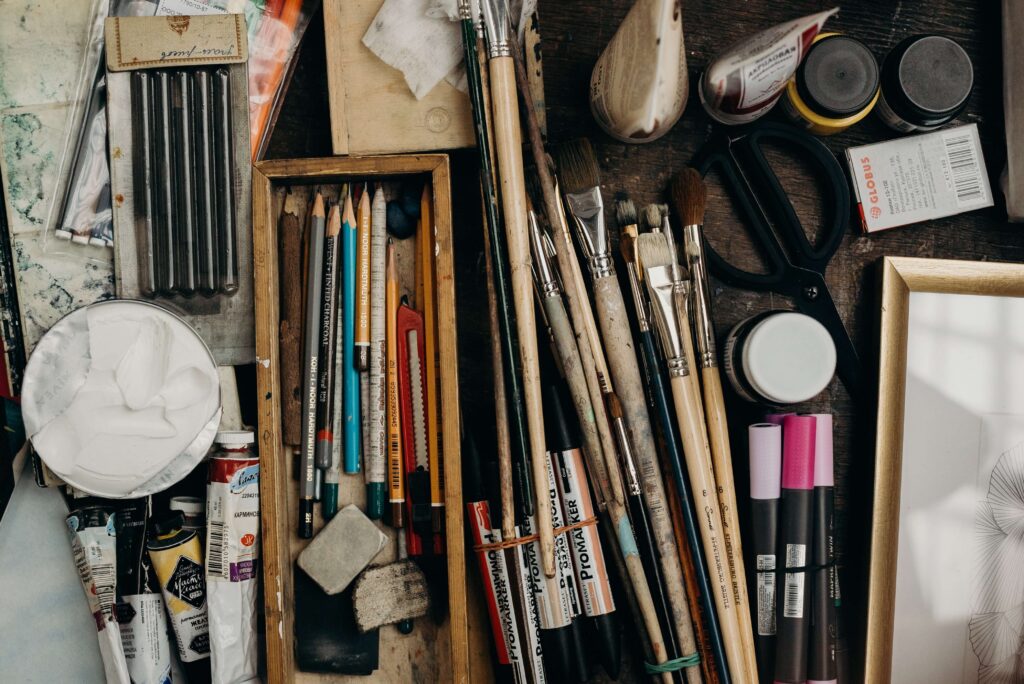
From brushes to canvas, every artist needs the right set of art tools to bring their ideas to life.
Contents
Basic Art Tools for Artists
If you are starting your path as an artist and want to make sure you have the right art tools, or you already have some experience and are ready to update or upgrade your art supplies, check this list of essential art tools.
Pencils
Pencils are the ultimate essential in your art tool kit. Why? They are your go-to tool for sketching, filling your art journal with ideas that might grow into an art piece, and of course, they might be the main tool if you want to do a pencil drawing.
What kind do you need? You can choose between traditional and mechanical pencils with different hardness: 9H (lightest) to 9B (darkest). The name tells you the type of line and effect you can achieve: hard and bold, light and soft, smearable or blendable, and even if it’s easy to erase or draw over it.
If you are just getting started you might want to get the basics: an HB pencil for sketching, a 2B for drawing details and contrast, a 6B for shading, and a 9B for darker tones and blending.
Brushes
There is such a wide variety of brushes that finding the right set (or building up your own) can be a bit overwhelming. The first thing to choose is the type of bristle from natural (they are made out of animal hair) to synthetic bristles. A soft bristle provides a soft and smooth stroke while brushes with a harsher bristle create rough and thick layers of paints
The second step is choosing the right shape for the type of stroke, line, and texture you want. There are the essential brushes you need in your art toolset:
-Flat brushes: these are very versatile; they can help cover large areas with flat strokes and also (when using their edges) create fine lines.
-Round brushes: provide a smooth stroke. They are available in both blunt and pointed tips, these last ones are ideal for creating details and thin lines.
-Filberts: this is a bit of a mix, it is a flat brush with a rounded tip offering a wide variety of marks and lines.
-Fan: are looking to create a particular texture? This is your tool! A flat brush with a splayed bristle and a round tip. This type of brush is helpful for softening edges, blending, and creating effects.
-Wash brushes: these flat and wide brushes are ideal to cover large surfaces because they can hold a lot of paint. Ideal for big format paintings.
Always remember to clean them properly to maintain the brush quality.
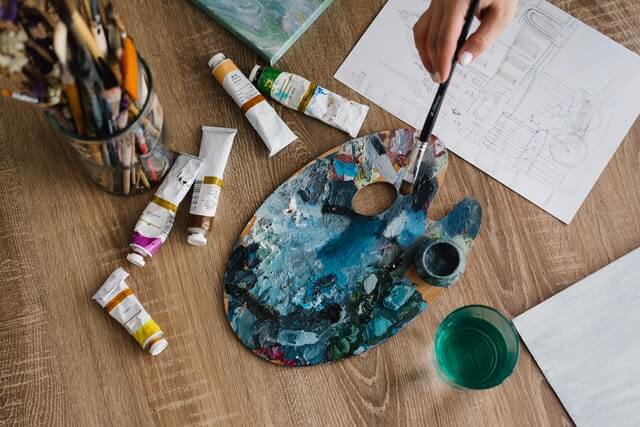
Paint
Acrylic, oil, gouache, graffiti, watercolors. When it comes to the type of paints artists have many options to choose from. It depends on what you want to create and the medium you’ll use.
Truth is, every artist has their favorite type and brand, each paint has different pigments and properties. If you are starting out, acrylic paint is a good place to begin, you can go for medium quality paint to experiment and then you can start discovering new materials and investing in them.
You don’t need all the paint tubes available: think about a few basics for your color palette and how you can mix them to achieve different hues.
Paper
In order to question yourself “What should I paint?”, first you need something to paint on, that’s why you need to get yourself the right blank medium to make it happen. When choosing paper, you can go with either pads or journals. Acid-free sheets are preferred by many artists because it prevents deterioration and discoloration.
Another characteristic to take into account is the weight of the paper, this term refers to its thickness. Lighter paper is thinner and might not resist wet media or using an eraser. Paper also has a texture created by its “teeth” or the little bumps you might find on its surface, which function is holding the pigments.
This is a list of different types of paper every artist should have in their studio:
-Drawing paper: this is the preferred option for finished art pieces, it’s a bit more expensive than other pads. Drawing paper is thicker (100lb/163g) with a medium tooth (bumps in the surface that create texture) and it’s ideal for dry media like pencils.
-Sketch paper: as its name implies, this thinner version of drawing paper is used for practicing and outlining future creations.
-Watercolor paper: this paper has cotton intertwined in its fibers which allows it to absorb more water. It’s thicker than drawing paper (140lb/300g) and has a bit of a texture.
-Mixed-media: this type of paper was created with the intention of providing artists with a surface that could withstand a variety of media techniques from watercolors, to markers and inks!
-Print-making: this medium is very versatile and ideal for works that require a great number of inks like high-quality prints. Its surface is coated, preventing the pigments from sinking down to its fibers, this enables you to create reproductions of your design with bright colors.
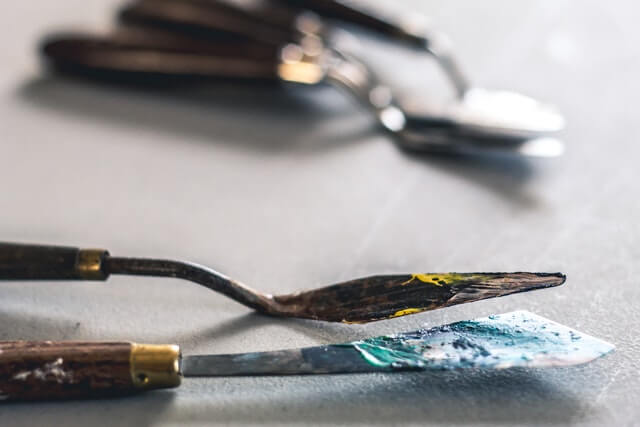
Palette
A palette is a surface an artist uses to hold and mix their paints. Palettes come in different sizes, shapes, and materials, from plastic to glass, metal, and ceramic. This tool should be light and easy to hold, making it easier to work without constant interruptions.
The palette should have enough space to put all the colors you are going to use plus extra space for mixing and trying colors.
There is no need to make a great investment in a palette but think about something that was made to last.
Palette Knife
Palette knives are used to mix different paints in a palette to create different shades and hues, but they can also be used to apply paint over the paper directly, it provides a thicker and textured stroke of color ideal, they work well with acrylic paints.
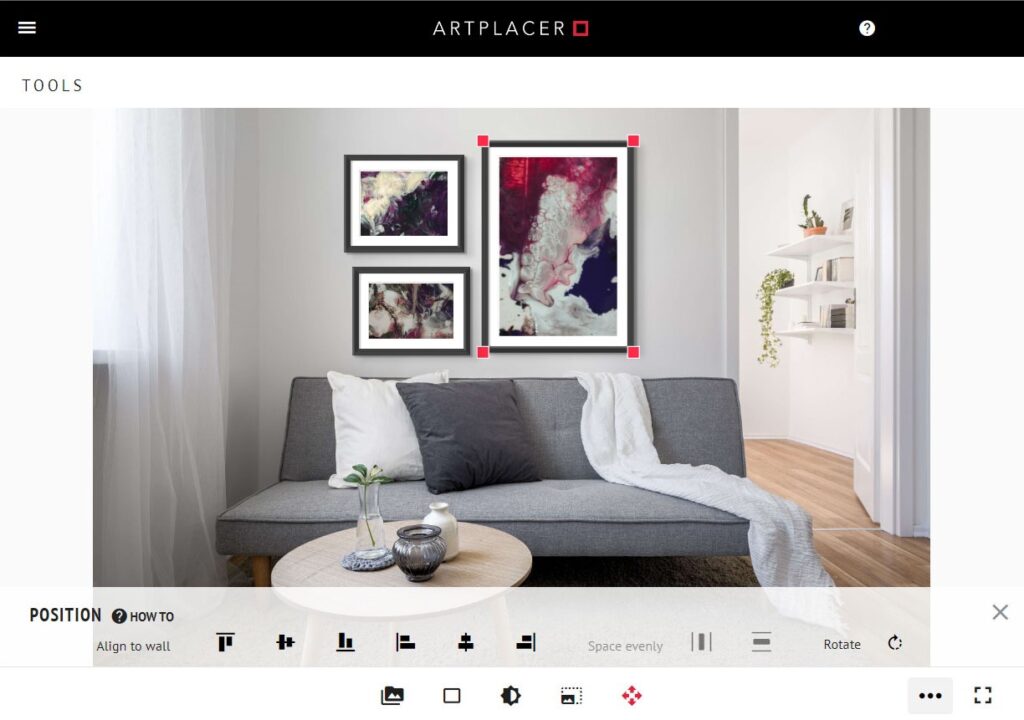
Digital art tools are now essential for artists for both the creation and presentation of their artwork.
New art supplies: apps and digital tools for artists
Today tools for artists go beyond the traditional pencil and sketchbook, digital tools are not only redefining what we understand as essential tools for artists, they provide different solutions and opportunities for creators.
For example, graphic or image editors are now an essential part of an artist’s work, they allow the creator to edit the image, add new layers to the design, and play around with the value and brightness of the image. And there are many alternatives in the market available.
Drawing tablets are the new canvas for many creators, its pressure sensitivity allows you to draw in detail with a pen tab, giving you the feel of a traditional sketchbook but with all the available tools of drawing software.
But what can you do when your artwork is ready to be shared with the world? Here is where digital art tools like ArtPlacer’s Room Mockups come in handy. With a few clicks, you can: upload your artworks, “drag and drop” them into a digital mockup of a room (everything from living rooms to halls), choose or create your own frame, adjust the brightness and shadow, and create an image ideal for your professional website or your social media profiles.
Now that you have a list of essentials it is time to get your first toolkit ready or upgrade the one you already have and start creating!
